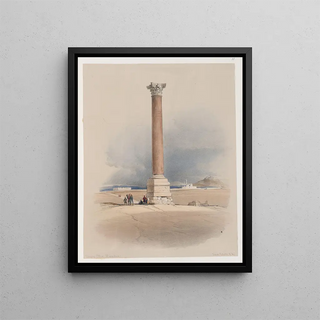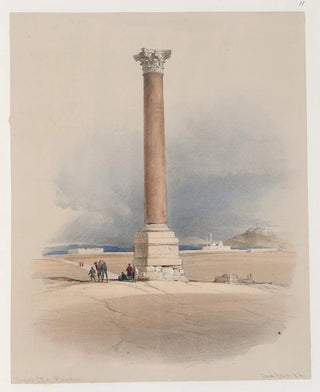Art print | Column of Pompée at Alexandria - David Roberts Source: Reproduction | Colonne de Pompée à Alexandrie - David Roberts


View from behind

Frame (optional)
The "Colonne de Pompée à Alexandrie" is an iconic art print that transports viewers on a journey through time and space. David Roberts, a 19th-century Scottish artist, masterfully captures the essence of this monument rich in history, erected in honor of the Roman general Pompey. This art print, faithful to the original, evokes not only the grandeur of antiquity but also the fascination that the cultural heritage of vanished civilizations exerts on us. Gazing at this piece, one feels immersed in the atmosphere of Alexandria, a city that, at its peak, was a crossroads of knowledge and exchange.
Style and uniqueness of the art print
David Roberts' style is distinguished by his meticulous attention to detail and his ability to create vibrant atmospheres. In "Colonne de Pompée à Alexandrie," he uses play of light and shadow to emphasize the majesty of the column, which seems to stand proudly against the azure sky. The warm, earthy colors, typical of his Eastern landscapes, give the art print emotional depth. Roberts does not merely reproduce a monument; he transforms it into a true scene of life, populated with men and women who, through their presence, recall the dynamism of a city in full effervescence. This marriage of realism and romanticism makes this piece a masterwork, where each brushstroke tells a story.
The artist and his influence
David Roberts is often regarded as one of the pioneers of Romanticism in British art. His travels in Egypt and the Middle East profoundly influenced his artistic production, allowing him to capture landscapes and monuments with a unique sensitivity. Through his works, he not only documented iconic locations but also helped shape Western perceptions of the Orient. His pictorial approach, imbued with sincere admiration for the cultures he encountered, paved the way for many artists who followed in his footsteps. By celebrating the beauty of ancient ruins and exotic landscapes, Roberts succeeded in awakening a lasting interest in history and archaeology.

Matte finish

View from behind

Frame (optional)
The "Colonne de Pompée à Alexandrie" is an iconic art print that transports viewers on a journey through time and space. David Roberts, a 19th-century Scottish artist, masterfully captures the essence of this monument rich in history, erected in honor of the Roman general Pompey. This art print, faithful to the original, evokes not only the grandeur of antiquity but also the fascination that the cultural heritage of vanished civilizations exerts on us. Gazing at this piece, one feels immersed in the atmosphere of Alexandria, a city that, at its peak, was a crossroads of knowledge and exchange.
Style and uniqueness of the art print
David Roberts' style is distinguished by his meticulous attention to detail and his ability to create vibrant atmospheres. In "Colonne de Pompée à Alexandrie," he uses play of light and shadow to emphasize the majesty of the column, which seems to stand proudly against the azure sky. The warm, earthy colors, typical of his Eastern landscapes, give the art print emotional depth. Roberts does not merely reproduce a monument; he transforms it into a true scene of life, populated with men and women who, through their presence, recall the dynamism of a city in full effervescence. This marriage of realism and romanticism makes this piece a masterwork, where each brushstroke tells a story.
The artist and his influence
David Roberts is often regarded as one of the pioneers of Romanticism in British art. His travels in Egypt and the Middle East profoundly influenced his artistic production, allowing him to capture landscapes and monuments with a unique sensitivity. Through his works, he not only documented iconic locations but also helped shape Western perceptions of the Orient. His pictorial approach, imbued with sincere admiration for the cultures he encountered, paved the way for many artists who followed in his footsteps. By celebrating the beauty of ancient ruins and exotic landscapes, Roberts succeeded in awakening a lasting interest in history and archaeology.






